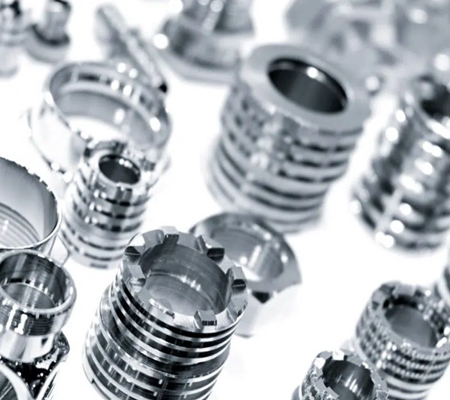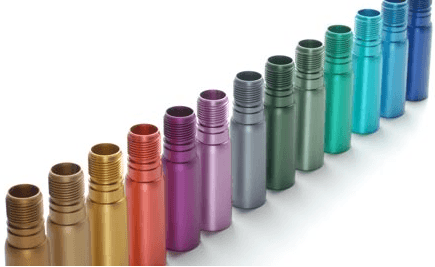
Advithiya Industries provides custom CNC milling services for plastic & metal parts. Utilizing our state of the art multi-axis CNC machining centers, we specialize in manufacturing a diverse range of both simple & intricate CNC milled components. Whether you require prototypes or production parts, our skilled teams are committed to delivering excellence with focus on cost-effectiveness. Additionally, we offer a variety of surface finish options to ensure that your machined part meets your precise specifications.
We have 3-axis, 4-axis and 5-axis VMC machines. 3-axis VMC machines operate on X,Y and Z axes. Which is the most commonly used CNC milling process. They are often used to produce simple parts with relatively small geometry. On the other hand 4axis & 5-axis VMC machines stand as an advanced & industry-leading category of CNC milling technology, symbolizing the extensive manufacturing capabilities within the realm of custom CNC milling. This cutting-edge machinery empowers the machining of multiple sides of a workpiece in a single setup, eliminating the need for multiple configurations. In comparison to 3-axis VMC processes, this approach demonstrates remarkable efficiency and enables the creation of intricately designed components with exceptional precision.

CNC turning process encompasses a broad spectrum, allowing for the machining of diverse rotary surfaces. This includes operations like external turning, internal turning, Taper turning, Parting, Facing, boring, reaming, drilling, knurling, threading, grooving & more. The versatility of CNC turning at Advithiya industries ensures a comprehensive range of machining capabilities, providing solutions for various precision requirements in manufacturing.
Refining the surface through gentle abrasion can eliminate machining marks, burrs, machine lines, and adhesive residue on the component. This results in an enhancement of part flatness and a reduction in surface roughness, yielding a polished and consistent appearance.
A meticulous polishing technique is applied to achieve a reflective finish on standard plastic, metal components, as well as transparent acrylic and polycarbonate parts. This process aims to create a precisely even flat surface, imparting a professional-grade sheen or improving the optical transparency of transparent components.
From de-flashing to adhesive application, filling, modifications, insert integration, pre-fitting, measurements, and assembly, our skilled artisans meticulously attend to every engineering detail and design requirement. All post-processing is conducted internally, yet our team is adept at collaborating with clients by incorporating externally supplied components for finishing and assembly, including the incorporation of mating and fitting parts. This often brings to light engineering obstacles that may not be immediately evident in CAD design. We are committed to overcoming these challenges, providing effective solutions, and ensuring the successful completion of each project.
Machined components typically exhibit marks that align with the cutting tool's path. A machined finish, characterized by a smooth surface achieved solely through machine operations without additional polishing, often requires minimal manual intervention to eliminate burrs. This allows for prompt completion and delivery shortly after the machining process.
The standard machined surface roughness ranges from Ra 3.2 to 1.6 μm; A polished machined surface achieves a roughness of Ra 1.6 to 0.8 μm; For a super-finished surface, the roughness is further reduced to Ra 0.8 to 0.2 μm.
Bead blasting imparts a consistent matte surface finish to machined components, effectively eliminating tool and sandpaper marks. This process involves forcefully projecting an abrasive stream onto a surface under high pressure to either smooth rough surfaces, add texture to smooth ones, or remove surface contaminants. Key process parameters include adjusting the air pressure and selecting glass beads of varying sizes, ranging from #80 to #220.
Plating is a versatile and essential process that enhances the surface properties of various materials, providing both functional benefits and aesthetic appeal. Through techniques like electroplating, metals are deposited onto substrates, offering improved corrosion resistance, increased surface hardness, and enhanced wear resistance. Decorative plating, such as chrome or nickel finishes, adds a touch of elegance to products, while functional plating solutions cater to specific performance requirements. The art and science of plating contribute not only to the durability and functionality of components but also to the overall visual appeal, making it a pivotal aspect in various industries, from manufacturing to design.


Anodization is employed for its corrosion resistance, ability to increase surface hardness, and enhance wear resistance, catering to both functional and aesthetic objectives. The two primary types of anodizing are:
Type II anodizing, primarily utilized to craft components with a consistently appealing surface, offers commendable corrosion resistance and moderate wear resistance. It also boasts a diverse range of color dye options. The standard coating thickness varies: 12-18 μm for black, 8-12 μm for clear, and 4-8 μm for colored finishes.
Type III anodizing, also referred to as hard anodizing, provides exceptional corrosion and wear resistance, making it well-suited for functional applications. However, its color choices are more constrained, often limited to clear or black finishes. The typical coating thickness for Type III anodizing ranges from 30-125 μm.
Powder coating involves the application of a protective polymer layer onto the part's surface. This process utilizes the corona discharge phenomenon to ensure the effective adhesion of the powder coating onto the workpiece, resulting in a robust and wear-resistant finish. The standard thickness typically ranges from about 50 μm to 150 μm.
Custom text and logos can be printed on parts using various methods. Silk screening is suitable for larger surfaces and intricate graphics involving multiple colors. Pad printing is effective for curved surfaces, ensuring accurate and detailed printing. Laser etching is the optimal choice for creating precise and permanent marks on metals and select plastics.
